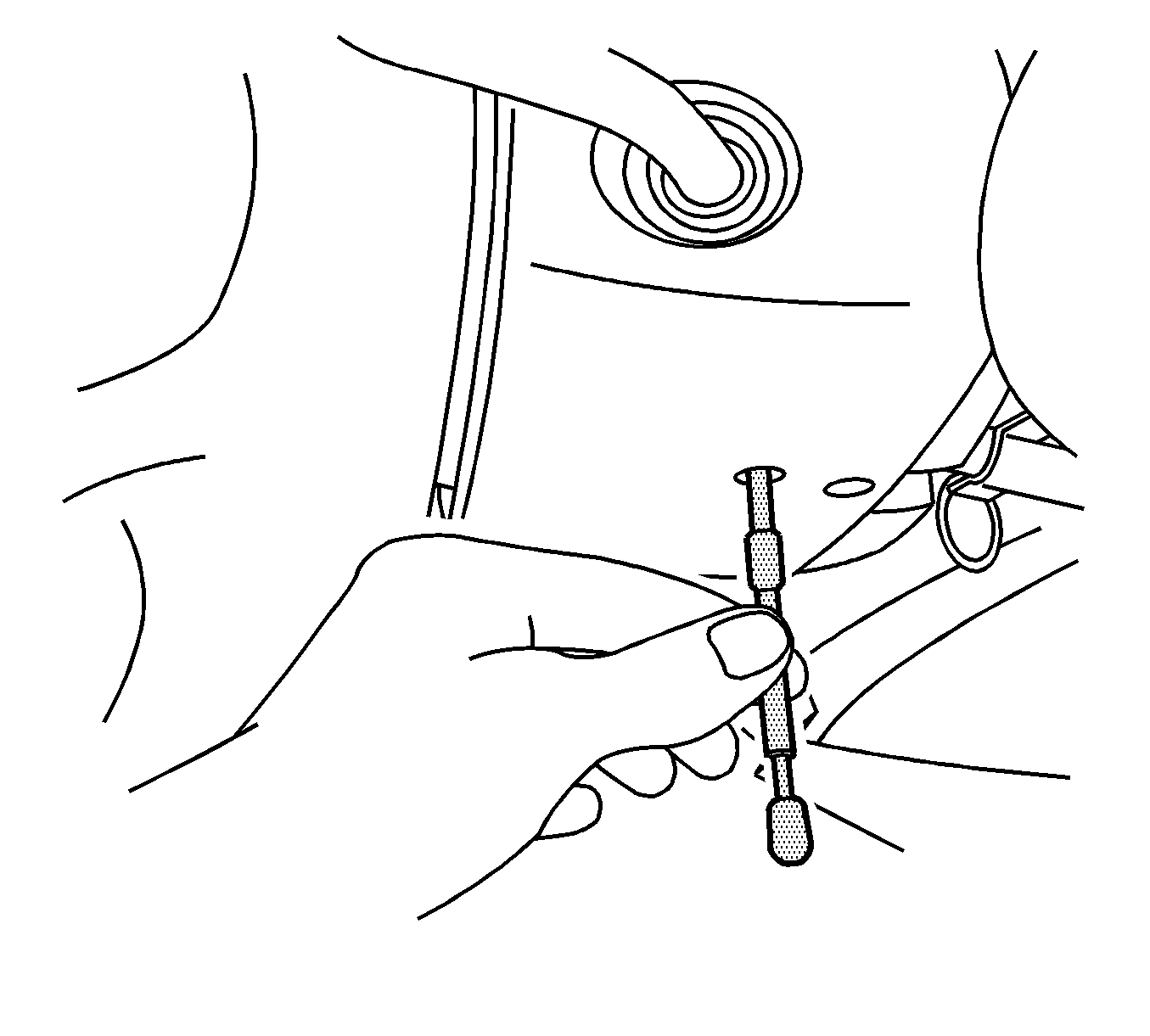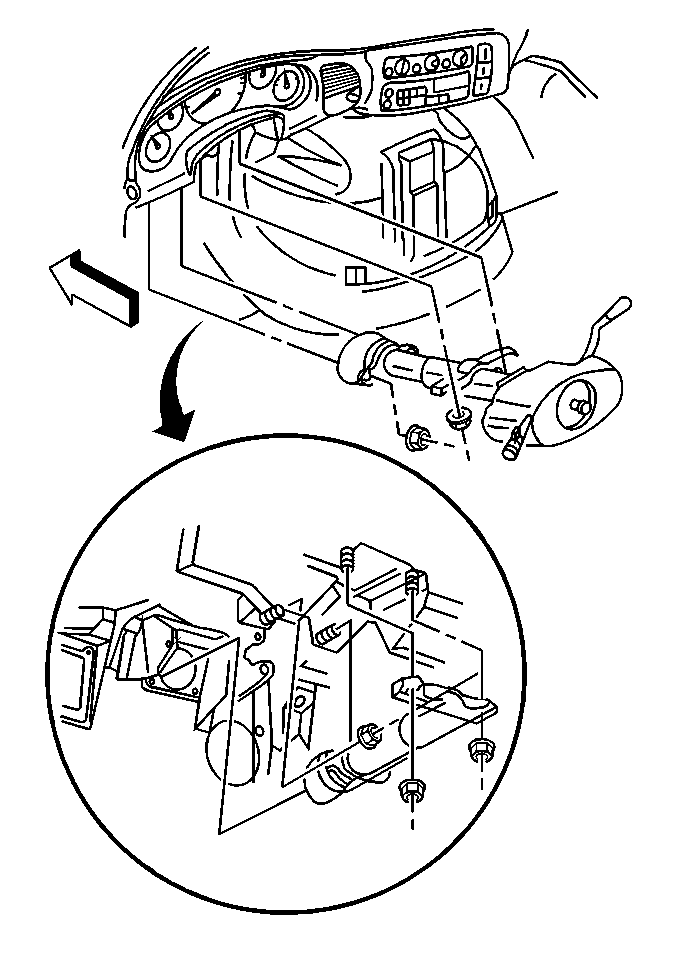Removal Procedure
Tools Required
J 42640 Steering Column Anti-Rotation Pin
Notice: Once the steering column is removed from the vehicle, the column is extremely susceptible to damage. Dropping the column assembly on the end could collapse the steering shaft or loosen the plastic injections, which maintain column rigidity. Leaning on the column assembly could cause the jacket to bend or deform. Any of the above damage could impair the columns collapsible design. Do NOT hammer on the end of the shaft, because hammering could loosen the plastic injections, which maintain column rigidity. If you need to remove the steering wheel, refer to the Steering Wheel Replacement procedure in this section.
Notice: The front wheels of the vehicle must be maintained in the straight ahead position and the steering column must be in the LOCK position before disconnecting the steering column or intermediate shaft. Failure to follow these procedures will cause improper alignment of some components during installation and result in damage to the SIR coil assembly.
- Disconnect the battery negative cable.
- Disable the supplemental inflatable restraint (SIR) system. Refer to Disabling the SIR System in SIR.
- Install the J 42640 in the steering column lower access hole.
- Remove the driver's side knee bolster. Refer to Driver Knee Bolster Replacement in Instrument Panel, Gauges and Console.
- Remove the air outlet duct. Refer to Lap Air Outlet Duct Replacement - Left Side in Heating and Ventilation - Non A/C.
- Remove the driver's side knee bolster deflector. Refer to Knee Bolster Deflector Replacement - Left Side in Instrument Panel, Gauges and Console.
- Remove the transmission control linkage from the column shift lever. Refer to Shift Cable Replacement in Automatic Transmission.
- Disconnect the 48-way connector wiring harness from the base of the steering column.
- Remove the steering wheel. Refer to Steering Wheel Replacement .
- Remove the intermediate shaft from the steering column shaft. Refer to Intermediate Steering Shaft Replacement .
- Remove the 2 lower steering column mounting nuts.
- Remove the 2 upper steering column mounting nuts.
- Disconnect the automatic shift lock control connector.
- Remove the steering column assembly.
Caution: Unless directed otherwise, the ignition and start switch must be in the OFF or LOCK position, and all electrical loads must be OFF before servicing any electrical component. Disconnect the negative battery cable to prevent an electrical spark should a tool or equipment come in contact with an exposed electrical terminal. Failure to follow these precautions may result in personal injury and/or damage to the vehicle or its components.



Support the steering column while loosening the nuts.
Installation Procedure
- Install the steering column through the cowl opening and onto the 2 lower studs.
- Raise the steering column into place.
- Loosely install the upper column mounting nuts. Do not tighten the nuts.
- Connect the automatic transmission shift lock control connector.
- Install the lower column mounting nuts.
- Install the intermediate shaft to the steering column shaft. Refer to Intermediate Steering Shaft Replacement .
- Install the transmission control linkage to the column shift lever. Refer to Shift Cable Replacement in Automatic Transmission.
- Install the steering wheel. Refer to Steering Wheel Replacement .
- Connect the 48-way steering column wire harness to the instrument panel wire harness.
- Install the driver's knee bolster deflector. Refer to Knee Bolster Deflector Replacement - Left Side in Instrument Panel, Gauges and Console.
- Install the air outlet duct. Refer to Lap Air Outlet Duct Replacement - Left Side in Heating and Ventilation - Non A/C.
- Install the driver's knee bolster. Refer to Driver Knee Bolster Replacement in Instrument Panel, Gauges and Console.
- Remove the J 42640 .
- Enable the supplemental inflatable restraint (SIR) system. Refer to Enabling the SIR System in SIR.
- Connect the battery negative cable.

Caution: In order to ensure the intended function of the steering
column in a vehicle during a crash and in order to avoid personal injury to
the driver, perform the following:
• Tighten the steering column lower fasteners before you tighten
the steering column upper fasteners. Failure to do this can damage the steering
column. • Tighten the steering column fasteners to the specified torque.
Overtightening the upper steering column fasteners could affect the steering
column collapse.
Notice: Use the correct fastener in the correct location. Replacement fasteners must be the correct part number for that application. Fasteners requiring replacement or fasteners requiring the use of thread locking compound or sealant are identified in the service procedure. Do not use paints, lubricants, or corrosion inhibitors on fasteners or fastener joint surfaces unless specified. These coatings affect fastener torque and joint clamping force and may damage the fastener. Use the correct tightening sequence and specifications when installing fasteners in order to avoid damage to parts and systems.
Tighten
| • | Tighten the lower column mounting nuts to 30 N·m (22 lb ft). |
| • | Tighten the upper column mounting nuts to 30 N·m (22 lb ft). |

Tighten
Tighten the wire harness connector bolt to 6 N·m (53 lb in).

